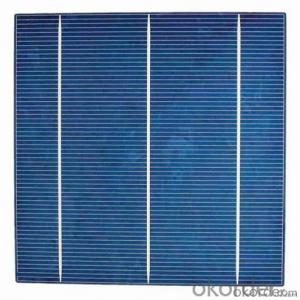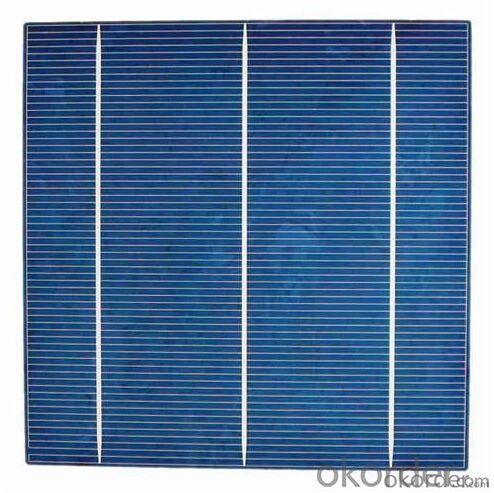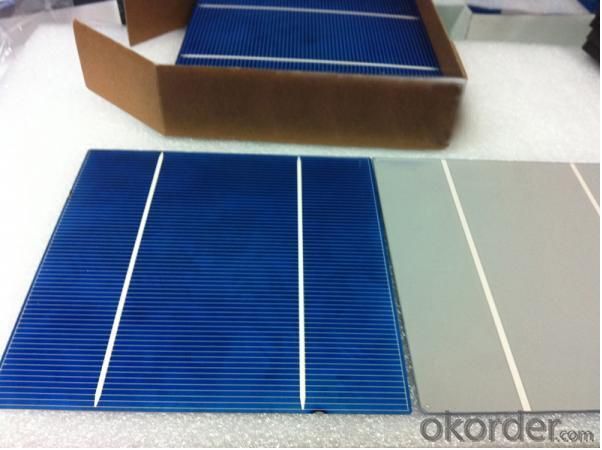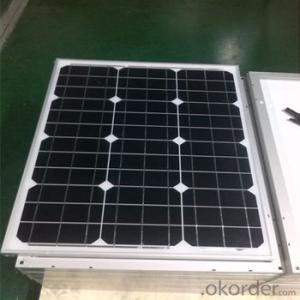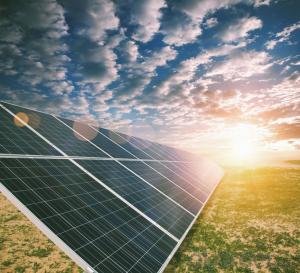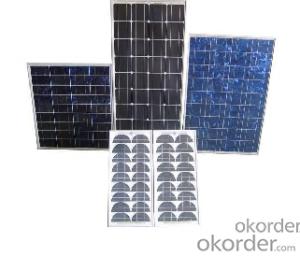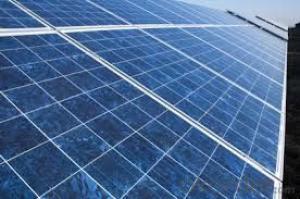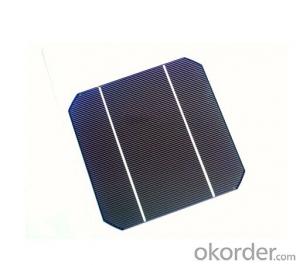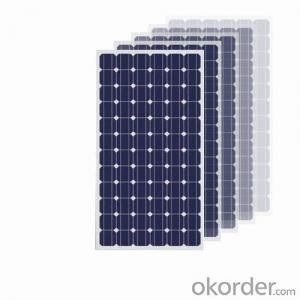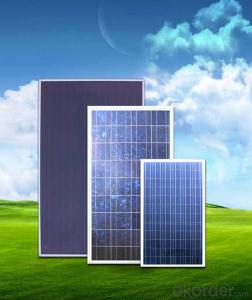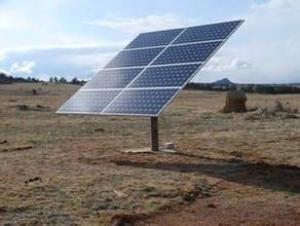Ecoflow Portable Solar Panels - Polycrystalline Solar Cells 2BB/3BB CNBM
- Loading Port:
- China main port
- Payment Terms:
- TT OR LC
- Min Order Qty:
- 4200 watt
- Supply Capability:
- 6000000 watt/month
OKorder Service Pledge
OKorder Financial Service
You Might Also Like
Polycrystalline Solar Cells 2BB/3BB CNBM
1.Product Description:
Specifications of Poly Solar Cells
Format | 156 mm × 156 mm ± 0.5 mm |
Thickness- | 210μm ± 40 μm |
Front (-) | 1.5mm bus bars (silver),blue anti-reflection coating (silicon nitride) |
Back (+) | 2.5mm wide soldering pads (silver) back surface field (aluminium) |
Temperature Coefficient of Poly Cells
Voc.Temp .coef.%/K | -0.351%/K |
Isc.Temp .coef.%/K | +0.035%/K |
Pm.Temp. coef.%/K | -0.47%/K |
Electrical Characteristic of Poly Cells
Efficiency | Efficiency | Pmax(W) | Average | Impp(A) | Vmpp(V) | Isc(A) | Voc(V) |
1720 | 17.20~17.40 | > 4.186 | > 4.186 | 7.94 | 0.528 | 8.515 | 0.626 |
1700 | 17.00~17.20 | 4.137~4.186 | 4.161 | 7.905 | 0.525 | 8.482 | 0.624 |
1680 | 16.80~17.00 | 4.088~4.137 | 4.113 | 7.863 | 0.521 | 8.402 | 0.623 |
1660 | 16.60~16.80 | 4.040~4.088 | 4.064 | 7.825 | 0.519 | 8.358 | 0.622 |
1640 | 16.40~16.60 | 3.991~4.040 | 4.015 | 7.769 | 0.517 | 8.304 | 0.621 |
1620 | 16.20~16.40 | 3.942~3.991 | 3.967 | 7.713 | 0.514 | 8.248 | 0.619 |
1600 | 16.00~16.20 | 3.894~3.942 | 3.918 | 7.67 | 0.511 | 8.204 | 0.616 |
2. Packing

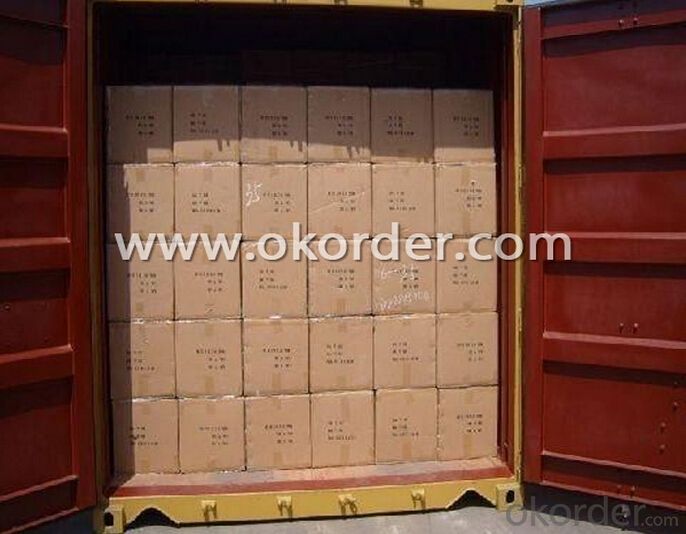
3.Advantages of Poly Solar Cells
1. High efficiency and High power.
2. Long-term electrical stability.
3. Lowest price and Fastest delivery.
4. Good quality and good service.
5. Bulk supply
6. Good Warranty
7. Big Sale
8. More than 25 years on the lifetime.
4.Usage and Applications of Poly Cells
Solar cells are often electrically connected and encapsulated as a module.
Photovoltaic modules often have a sheet of glass on the front (sun up) side, allowing light to pass while protecting the semiconductor wafers from abrasion and impact due to wind-driven debris, rain, hail, etc. Solar cells are also usually connected in series in modules, creating an additive voltage.
Connecting cells in parallel will yield a higher current;our solar cells have passed IEC Certification.
With high quality and stable quality. Our Cells can greatly improve the performance of Solar Modules.
5.Packaging & Delivery of Poly Cells
Carton Box Package and Deliver by air. It should be noticed that it should be avoid water, sunshine and moist.
- Q: Can solar panels be installed on a barn or agricultural building?
- Yes, solar panels can be installed on a barn or agricultural building. In fact, it is becoming increasingly common for farmers and landowners to install solar panels on their barns or agricultural buildings to generate renewable energy and reduce their dependence on traditional power sources.
- Q: Do they really save energy? Cut or almost eliminate your electricity bill, if so, how much?Do they have a reserve unit to save electricity that I don't use, to use when the sun is not out?Can it produce enough electricity to cool a house and keep lights and appliances runningLastly, how much are the panels are running for.
- It Can produce enough energy to run fans and yes keep the house cool. And if you also want to make one try it out. Good luck and save energy
- Q: Can solar panels be installed on airports?
- Yes, solar panels can be installed on airports. In fact, many airports around the world have already adopted solar energy systems to power their operations and reduce their carbon footprint. Solar panels can be installed on the roofs of airport buildings, canopies in parking lots, or even on open land surrounding the airport. They provide a sustainable source of clean energy and contribute to the overall sustainability efforts of the aviation industry.
- Q: Do solar panels require regular inspections?
- Yes, solar panels do require regular inspections to ensure optimal performance and identify any potential issues such as damage, debris, or faulty connections. Regular inspections can help in maintaining the efficiency and longevity of the solar panels.
- Q: Can solar panels be installed on metal roofs?
- Yes, solar panels can be installed on metal roofs. In fact, metal roofs are considered to be one of the best types of roofs for solar panel installation due to their durability, longevity, and ease of installation. The metal roof provides a stable and secure base for mounting the panels, ensuring optimal energy production. Additionally, the smooth surface of metal roofs allows for efficient panel placement, maximizing sunlight absorption.
- Q: I've been thinking and I'd like to have solar panels installed on my roof at some point to help reduce our electricity consumption- but I live in IL and in the winter it frequently snows. Is there such a thing as heated solar panels so they don't get coated w/ice or snow? Are solar panels even a feasible option in IL? Thank you, Anna
- Yes solar panels are a good way to save money. I know a friend of mine she has 2 solar panel she lives in IL.I i know she told me that this year she saved 500$ in electricity bills. Good luck!
- Q: how much energy does solar panels save you? (like a month, year, etc)
- It depends on the size of the solar panels and the intensity of the solar-light. So, there's difference in every place. It's impossible to answer unless there's detail of panel size, panel quantities, average rainfall, average solar days, etc.
- Q: Can solar panels be installed on museums or cultural centers?
- Yes, solar panels can be installed on museums or cultural centers. In fact, many museums and cultural centers are embracing solar energy as a sustainable and cost-effective solution for their energy needs. By installing solar panels, these institutions can reduce their carbon footprint, lower energy costs, and demonstrate their commitment to environmental stewardship. Additionally, the installation of solar panels on such iconic buildings can serve as a visual representation of their dedication to renewable energy, inspiring others to follow suit.
- Q: Harbor Freight sells a 75 watt solar panel, a surge power inverter, and deep charge batteries. But no one there can tell me how to put it all together. I want the end output to be a simple power bar that I can plug my devices into. I live in an apartment so I can not wire it directly into the grid. Please only serious responses. Don't waste your time and mine.
- i wouldn't. - harbor freight isn't known for the best quality stuff. - 75 watts assumes roof mounting, at 90 degrees to the sun, on a bright day. you're going to get considerably less. and only when the sun is highest in the sky. maybe you should look at, your computer, for example. if you're using it for 4 hours, and it has a 500 watt power supply, and you add 200-500 watts for the monitor, and some for the printer, modem, etc, you'd use 5kw that day. your 75 watt panel, generating maybe 50 watts at most, for maybe 4 hours when the sun was highest, and shining directly on the panel, would generate 200 watt hours. it would take 25 days to generate the electricity you'd use in single day. in the winter, you'd be pretty much out of luck. there just isn't enough bright sun. clearly, it's up to you, but there's a harbor freight near me, and i'll not be rushing out to get such a system. further, most appliances are quite voltage sensitive. you really do need to have the voltage in the 0-20 range. too much out, either higher or lower, will shorten the life of appliances at best.
- Q: Can solar panels be used to power a water pump?
- Yes, solar panels can be used to power a water pump. Solar panels convert sunlight into electricity, which can then be used to power a water pump. This allows for a sustainable and renewable energy source to operate the pump without relying on conventional electricity grids or fossil fuels.
Send your message to us
Ecoflow Portable Solar Panels - Polycrystalline Solar Cells 2BB/3BB CNBM
- Loading Port:
- China main port
- Payment Terms:
- TT OR LC
- Min Order Qty:
- 4200 watt
- Supply Capability:
- 6000000 watt/month
OKorder Service Pledge
OKorder Financial Service
Similar products
Hot products
Hot Searches
Related keywords
